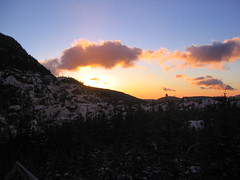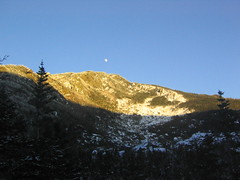Solitude and Red Mac
Thanks to Carrie, one of my guests this weekend, for taking this caretaking action photo. Reaming the sinks, without running water, is just one of the glamorous activities of the caretaking lifestyle.
In between two nearly-full houses on the last two Saturday nights, I spent a lot of quality time with nobody but me and the staticky voices of Terry Gross and other NPR personalities. By the time the weekend gives leave to the inmates of the global economy to keep me company in the mountains, my typically reserved personality becomes downright outgoing. It helped that my guests these past two weekends were funny, genial, and helpful as well.
This last Saturday was also a perfect winter day, sunny and mild, and the first day so far that I was able to recognize the daylight lingering after the 5 pm radio call. With the clear skies, I promised that night's guests a program on the winter constellations later on when everyone had finished dinner. But that took longer than expected, and by the time the kitchen was clean, Auriga, Orion and the rest were hidden behind clouds, the front lines of an approaching low-pressure system.
The approaching storm also brought winds that were gusting to 60 MPH that night, and so, while the wind generator howled periodically on the roof, I decided to substitute the star program with the tale of Red Mac McGregor.
Red Mac was one the first manager of the White Mountain huts system, probably best known as the man who hired Joe Dodge to work as the Pinkham Notch hutmaster in the 1920s. Red Mac started his AMC career as the hutmaster of Carter Notch Hut during some of the first summers of its existence. Carter Notch was his favorite hut, and he allegedly joked that when he died, his heaven would be on the shores of the Lakes of the Winds.
Years later, in the late 1970s, the AMC began to leave Carter Notch Hut open year-round. Whereas the winter season is currently split into two shifts (late fall caretakers work from October until Christmas, and winter caretakers work from Christmas until April), the first Carter winter caretakers worked, with biweekly days off, straight through from October until April. Furthermore, in those first few years, there were far fewer winter hikers, and caretakers could work for an entire ten-day stint without seeing anyone at the hut.
Joe Gill looked after Carter Notch during the third winter it was open, in 1978. On one evening late in March, near the end of his seasonal tenure, Joe woke up late in the night with a flashlight shining in his eyes. There had been no guests in the hut when he had gone to sleep, but late arrivals aren't uncommon, and someone had apparently wandered into the crew room to let him know that they had arrived.
"Can I help you?" said Joe as he squinted into the light. There was no answer, and the flashlight didn't move. He found another light that he kept near his bed and shone it across the room, and there he saw his own flashlight, switched on and pointed directly at him. He couldn't remember putting it there, and it would later strike him as strange that he would have been able to fall asleep in the first place with it shining in his face. But anxious to get back to sleep, and assuming that he had just forgotten to turn it off, Joe got up, crossed the room to turn off the light, and went back to sleep.
Later on in the same night, Joe woke up again, this time shivering and extremely cold. Anyone who has been camping in the winter will recognize the condition of being half asleep, too tired to get up and put more clothes on, but too cold to sleep soundly. Joe struggled with the problem for a while before the cold overpowered his torpor and he sat up to find an extra blanket. When he did, he noticed that the door to the crew room had blown open. When he got up to close it, he saw that the front door to the hut, which is directly opposite the crew room door, had also blown open, with the north winds blowing straight through both. He closed and latched them securely, found an extra blanket, and slept soundly until the morning.
Just as they do today, the front door and the crew room door open into the dining room of the hut. When he thought about his strange night, it occurred to Joe that it would be very difficult for the wind, from any direction, to blow open both doors in opposite directions at the same time.
A few days later, Joe hiked down to Pinkham Notch for his days off. In an offhand conversation with someone working at the visitors' center, he mentioned the unusual events that had kept him up a few nights before.
"What night did you say this all happened?" asked the visitors' center employee.
Joe told them the date.
"Well, that was the night that Red Mac McGregor died."
Since then, Carter Notch caretakers have reported various "Red Mac" sightings, or soundings: footsteps on the roof of the hut, clanking pots and pans in the kitchen before any guests are up for the morning, flashing lights in the thick spruce forests around the hut, etc. When I worked here in the spring of 2004, my co-caretaker Tiana reported hearing footsteps in the dining room early one guestless morning, and she attributed the noises to Red Mac. For my part, I have had better luck sighting the marten. When I hear strange noises, I have learned that it is better for a solitary caretaker to ignore them than to speculate on what supernatural sources they may have. But I have two more months at Carter, and it may be that the approaching springtime will make our resident haunt restless for another summer in the Notch.







